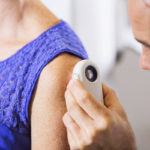Cosmetic Surgery Blog
Regular skin cancer screening exams can make a real difference.

Patients with a strong family history of melanoma may have germline mutations that put them at high risk for melanoma themselves. A study of these high-risk patients found that regular skin cancer screening exams and education lead to detection of melanoma at a significantly earlier stage than the melanomas detected without regular skin cancer screening. 83% of melanomas detected in the frequent screening group were at the early T1 stage whereas only 40% of melanomas in the regular group were in the early stage. The take-home message is: if you have a personal history or strong family history of melanoma, in addition to checking your own skin, it is well worth getting regular skin cancer screening exams by your dermatologist.
Article Citation
The Impact of Longitudinal Surveillance on Tumor Thickness for Melanoma-Prone Families with and without Pathogenic Germline Variants of CDKN2A and CDK4.
Michael R. Sargen, Ruth M. Pfeiffer, David E. Elder, Xiaohong R. Yang, Alisa M. Goldstein and Margaret A. Tucker
Cancer Epidemiol Biomarkers Prev 2021;30:676–81
Could Statin Drugs decrease the risk of Metastatic Melanoma?

Statin drugs are amongst the most commonly prescribed medications in America. Their primary role is in lowering high lipid levels to mitigate against the increased risk of heart disease associated with high lipids. However these same medications can have many other effects.
A recent study shows that in the laboratory melanoma cells that show genetic markers for the ability to metastasis, (spread beyond the skin), can have these genetic markers improved by exposure to statin drugs.
At the same time a chart review of 475 melanoma patients indicated that those taking statin drugs had a lower risk of developing metastasis compared to patients not taking statins. (24.7% for statin users vs 37.6% for those not taking statins.)
While this is all very preliminary, it suggests that taking statin drugs may do more than just protect your heart. They may lower the risk of metastasis in patients with melanoma. Obviously more research is needed to confirm this notion and calculate the risk benefit ratio of using statins in this way. None the less there is a good chance that a medication that has been out there for many years could help in the fight against melanoma.
Article Citation
Journal of Investigative Dermatology
Computational Drug Repositioning Identifies Statins as a Modifier of Prognostic Genetic Expression Signatures and Metastatic Behavior in Melanoma
J Invest Dermatol 2021 Jan 05;[EPub Ahead of Print], WY Yu, ST Hill, ER Chan, JJ Pink, K Cooper, S Leachman, AW Lund, R Kulkarni, JS Bordeaux
Risk of Invasive Skin Cancer

It is well recognized that having one basal cell cancer means that you probably have a 50% chance of one day developing a second basal cell cancer. However the risk of future invasive skin cancer in patients with only squamous cell cancer in situ (the earliest stage of skin cancer) was not clear. Now a study has calculated that in patients with a history of squamous cell cancer in situ there is an over 15 x the risk of developing an invasive squamous cell cancer in the future. This reminds us that not only is it important to correctly treat all skin cancer but the subsequent follow up and surveillance in these patients is vital. In my practice, I suggest that all patients with a history of basal cell cancer or squamous cell skin cancer (including squamous cell cancer in situ) monitor their own skin with a self-exam every month and get a complete skin cancer screening exam from their dermatologist every 6 months.
Article Citation
JAMA Dermatology
Assessment of Cutaneous Squamous Cell Carcinoma (cSCC) In Situ Incidence and the Risk of Developing Invasive cSCC in Patients With Prior cSCC In Situ vs the General Population in the Netherlands, 1989–2017
JAMA Dermatol 2020 Jul 01;[EPub Ahead of Print], S Tokez, M Wakkee, M Louwman, E Noels, T Nijsten, L Hollestein
Simple antihistamines and melanoma.

Previous studies have shown that the same antihistamines have survival benefits in breast cancer. Now we see the same thing concerning malignant melanoma. However, more research is required to confirm the results,” emphasises Professor Håkan Olsson. He is one of the researchers behind the study, which was recently published in the research journal, Allergy.
We observed improved survival among those who used desloratadine and to a certain extent also loratadine, particularly in the age group 65 and older, when we compared with those who had not used antihistamines. The use of the other antihistamines showed no significant survival effect. The use of desloratadine and loratadine also seemed to reduce the risk of getting a new malignant melanoma,” says Håkan Olsson.
The finding is very exciting especially as these medications have virtually no side effects. However, (there is always a but), further studies are needed to confirm and explain these results.
We are collaborating with researchers in Barcelona and Stockholm. In Lund, we are underway with studies in both animal and human subjects, in which doses of antihistamines will be compared with the patients who do not take antihistamines, in order to measure the treatment effect,” concludes Håkan Olsson.
Article Citation
Ildikó Fritz, et al. Desloratadine and loratadine use associated with improved melanoma survival. Allergy, 2020; DOI: 10.1111/all.14273
Good News at last!

Melanoma can be a deadly disease. And for many years, apart from surgically removing the tumor, there was little else medicine had to offer if the cancer had spread to other organs. In fact melanoma mortality rates increased by 7.5 percent from 1986 to 2013. However, now there is a whole new armamentarium at the disposal of the oncologist. Ten new treatments for metastatic melanoma were approved by the FDA beginning in 2011. As a result, overall mortality decreased by 17.9 percent from 2013 to 2016. “This is the first report of a statistically significant, multiyear reduction in the mortality rate for cutaneous melanoma across an entire nation,” the authors write. The research that has been going on for many years is now bearing fruit. Lets hope the trend continues as new innovations continue to be developed.
Article Citation:
New Systematic Therapies and Trends in Cutaneous Melanoma Deaths Among US Whites, 1986–2016
Juliana Berk-Krauss MD, Jennifer A. Stein MD, PhD, Jeffrey Weber MD, PhD, David Polsky MD, PhD, and Alan C. Geller RN, MPH
Am J Public Health. Published online ahead of print March 19, 2020: e1–e3. doi:10.2105/AJPH.2020.305567
Sexual Orientation and risk of Skin Cancer

A recent study looked at the prevalence of skin cancer in 845 264 participants and the relative risk of skin cancer based on sexual orientation. They found that gay and bisexual men had a higher prevalence of skin cancer compared to heterosexual men. The reasons are not elucidated by this study but could be related to increase use of sun and artificial tanning. However the authors do suggest that the finds should encourage increased patient education and community outreach initiatives focused on reducing skin cancer risk behaviors among gay and bisexual men.
Article Citation
JAMA Dermatology
Association Between Sexual Orientation and Lifetime Prevalence of Skin Cancer in the United States
JAMA Dermatol 2020 Feb 12;[EPub Ahead of Print], S Singer, E Tkachenko, RI Hartman, A Mostaghimi
Melanoma: Its mainly about U.V exposure, (but not always).

We know that ultra-violet radiation (UV) is a carcinogen and that sun exposure or indoor tanning are risk factors for melanoma. However we also know that not all melanomas are due to UV exposure. In a recent study from the American Cancer Society investigators tried to qualify the amount of melanoma that is related to UV exposure vs other causes. Their conclusion is not completely surprising. The researchers found that during 2011 to 2015, the estimated number of melanoma cases attributable to UV exposure in the United States was 338,701, that is 91% of the total cases. The effect of UV exposures causing melanoma was most prevalent in sunny climates. So the highest association was in Hawaii where they estimated over 97% of melanomas were UV induced. This contrasts with the District of Columbia where only about 88% of melanomas where thought to be UV induced. This just goes to emphasis the need for good UV avoidance / protection especially if you are living in a sunny environment. It also though reminds us that melanomas can occur in none sun exposed areas too. So remember to check all of you skin not just the exposed parts.
Article Citation
Cutaneous melanomas attributable to ultraviolet radiation exposure by state.
Farhad Islami et al
Int. J. Cancer: 00, 00–00 (2020)
Make sure your dog keeps its paws off you medicine!

Dogs will eat anything! So be careful not to give them the opportunity to ingest your medications. In a recent publication it became clear that there have been several deaths of pets as a result of them ingesting the topical cream 5-Flurouracil (Efudex or Carac). This topical chemotherapy cream is often used in humans to treat extensive sun damaged areas of the skin with multiple actinic keratoses (“pre-cancers”). However it seems dogs dont mind the taste and given the opportunity may squeeze out the tube and snack on the contents. The fatality rate in canines presenting with 5-Flurouracil ingestion has been reported to be as high as 61%.
This is not a reason not to use your prescribed cream, but just keep it out of the reach of children and pets!
Article Citation
The British Journal of Dermatology
Under-Recognised Effects on Our Canine and Feline Companions With 5-Fluorouracil Use
Br J Dermatol 2019 Nov 09;[EPub Ahead of Print], B Ho, N Bates, N Edwards, N Robinson, J Ellison
Skin Cancer and Internal Malignancy. Another thing to worry about!

Patients with a history of a none melanoma skin cancer such as basal cell or squamous cell cancer are at higher risk of subsequent basal cell or squamous cell cancers. However a recent study from Korea has suggested that these patient may also be at risk for other types of malignancies such as bone cancer or cervical cancer. This nationwide cohort study, compared 27 259 none melanoma skin cancer patients with 54 518 matched controls without skin cancer, Patients were followed for 8 years to observe the development of any internal malignancies after a diagnosis of skin cancer.
The risk was significantly higher in the patients with skin cancer. Bone cancer showed the highest risk followed by nasal cavity and larynx , oral cavity and pharynx (HR , anus and anal canal and cervical cancers with risks greater than five-fold higher in none melanoma skin cancer patients compared with the controls.
So now when you get you diagnosis of skin cancer you need to get it treated, take precautions to limit your risk of future skin cancers, monitor your skin carefully for any suspicious lesions, and be aware that you may be at higher risk for several other unrelated malignancies!
However these results were from a relatively none diverse patient population and still need to be confirmed by other studies. How much “extra” risk of these internal malignancies Americans with skin cancer will have is yet to be definitively determined.
Article Citation
Journal of the European Academy of Dermatology and Venereology: JEADV
Non-Melanoma Skin Cancer as a Clinical Marker for Internal Malignancies: A Nationwide Population-Based Cohort Study
J Eur Acad Dermatol Venereol 2019 Sep 08;[EPub Ahead of Print], SJ Yun, JM Bae, H Kim, BC Park, JS Kim, SH Seo, HH Ahn, DY Lee, YC Kim, HJ Park, KY Chung
Younger generation seem to be getting the message about melanoma!

While the overall incidence of melanoma seems to be on the rise, there was a significant lowering in the rate of melanoma in among adolescents (10–19 years of age) and young adults (20–29 years of age). Using registry data, these authors evaluated 988,103 cases of invasive melanoma and found that, the overall incidence of melanoma increased from 200 to 229 cases per million person-years from 2006 to 2015, respectively. However over the same period the incidence among adolescents (10–19 years of age) and young adults (20–29 years of age) significantly declined. Incidence rates of melanoma decreased by an annual percentage change of −3.6% to −5.4% in both males and females in these age ranges. The declining incidence of melanoma among adolescents and young adults may be a result of the efforts promoting sun protective interventions and that messaging having a real impact on the behavior of the younger generation. Lets hope the trend continues!
Age-Specific Incidence of Melanoma in the United States
JAMA Dermatol 2019 Nov 13;[EPub Ahead of Print], KG Paulson, D Gupta, TS Kim, JR Veatch, DR Byrd, S Bhatia, K Wojcik, AG Chapuis, JA Thompson, MM Madeleine, JM Gardner
